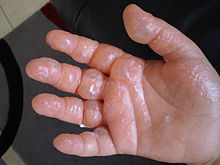Phytophotodermatitis
The photosensitizing substances found in phototoxic plants belong to a class of chemical compounds called the furanocoumarins, which are activated by long-wavelength ultraviolet (UV-A) light.Bergapten and xanthotoxin (also known as methoxsalen), two linear furanocoumarins derived from psoralen, are invariably found in plants associated with phytophotodermatitis.[12] False bishop's weed (Ammi majus), the world's major source of the linear furanocoumarin xanthotoxin, has been used since antiquity to treat vitiligo[2] but accidental or inappropriate use of this plant can lead to phytophotodermatitis.In the family Rutaceae, the most severe reactions are caused by the essential oil of the bergamot orange (Citrus bergamia).The first and best line of defense against phytophotodermatitis is to avoid contact with phototoxic substances in the first place: A second line of defense is to avoid sunlight, so as not to activate a phototoxic substance: Phytophotodermatitis is triggered by long wavelength ultraviolet light (called UVA) in the range of 320–380 nanometers,[7] so the best sun-protective clothing and sunscreen products will block these wavelengths of UVA radiation.In 2011, the U.S. Food and Drug Administration (FDA) established a "broad spectrum" test for determining a sunscreen product's UVA protection.A dermatologist may also prescribe a whitening cream to help treat the hyperpigmentation and return the skin pigmentation back to normal."[2] In A.D. 50, the Greek physician Dioscorides observed that pigment would return to patches of vitiligo if "cataplasmed with the leaves or the boughes of the Black Figge,"[39] an apparent reference to Ficus carica, the common fig.One of the earliest reports of plant-based dermatitis was given by Chaumton in 1815, who noted that the outer rind and root of cow parsnip (a common name for any Heracleum species of plant) contained an acrid sap sufficiently strong to inflame and ulcerate the skin.[54][2] He was unaware that, in 1916, Freund had correctly observed that these pigmentation effects were due to sun exposure after the use of Eau de Cologne, a perfume infused with bergamot oil.

Lyme diseaselime juiceSpecialtyDermatologyphotosensitizerDifferential diagnosisskin burnallergic contact dermatitiscutaneousphototoxicultraviolet Aerythemablistershyperpigmentationimmunologic responsefuranocoumarinslinear furanocoumarinsBergaptenmethoxsalenpsoralenmelaninchild abuseApiaceaeRutaceaeMoraceaeFabaceaeAmmi majusvitiligoceleryparsnipparsleyinvasive speciesPastinacaHeracleumHeracleum persicumHeracleum sosnowskyiHeracleum mantegazzianumNotobubon galbanumAnthriscus sylvestrisDaucus carotaAngelicaAngelica gigasHeracleum sphondyliumHeracleum maximumcitrusessential oilbergamot orangeBergamot essential oilDictamnus albusRuta graveolenscommon figFicus pumilacitrus fruitssunscreensun protective clothinginflammatorydermatologistwhitening creamhypopigmentationDioscoridesdermatitisEau de Colognebergamot oilDarrell WilkinsonList of cutaneous conditionsPhotodermatitisPhotosensitivity in humansStinging plantDiseasesDBphotodermatosesUltravioletionizingSunburnSolar urticariaPolymorphous light eruptionBenign summer light eruptionJuvenile spring eruptionAcne aestivalisHydroa vacciniformeSolar erythemaNon-ionizingActinic raysActinic keratosisAtrophic actinic keratosisHyperkeratotic actinic keratosisLichenoid actinic keratosisPigmented actinic keratosisActinic cheilitisActinic granulomaActinic prurigoChronic actinic dermatitisInfraredErythema ab igneKangri ulcerKairo cancerKang cancerPeat fire cancerCutis rhomboidalis nuchaePoikiloderma of CivatteRadiation dermatitisChronic radiodermatitisFavre–Racouchot syndromePhotoagingPhotosensitivity with HIV infectionPhototoxic tar dermatitis